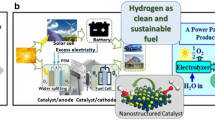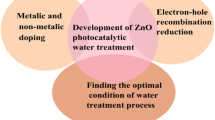Abstract
Electrochemical wet absorption composite system has an excellent potential to remove Hg0 from flue gas. In this study, ruthenium iridium titanium platinum quaternary composite electrode is used as an anode and titanium electrode is used as the cathode, and KI/I2 absorption solution is introduced into the electrocatalysis system as an electrolyte to form KI/I2 electrochemical catalytic oxidation system. The removal rate of Hg0 in flue gas can be increased to 92.3%. The effects of electrolytic voltage, current, Pt content, I2 concentration, and the ratio of KI/I2 on the removal of Hg0 were discussed. The possible free radicals in the electrochemical cathode, anode, and solution were characterized and tested by XRD, SEM, UV-Vis (detection of H2O2, ·OH, O3), and FTIR (detection of IO3-). Combined with experimental data and theoretical derivation, the mechanism of Hg0 removal from flue gas by electrochemical catalytic oxidation alloy formation wet absorption combined process was studied. The results show that the combined process, which is a promising technology can not only improve the removal efficiency of Hg0, but also realize the resource recovery of Hg0 and I2, and provide a feasibility study for the subsequent regeneration of KI/I2 absorption solution.






Similar content being viewed by others
Data availability
Not applicable
References
Bader H, Hoigni J (2013) Determination of ozone in water by the indigo method. Water Research 15(4):449–456. https://doi.org/10.1016/0043-1354(81)90054-3
Bose-O’Reilly S, McCarty KM, Steckling N, Lettmeier B (2010) Mercury exposure and children’s health. Current Problems in Pediatric and Adolescent Health Care 40(8):186–215. https://doi.org/10.1016/j.cppeds.2010.07.002
Brillas E, Casado J (2002) Aniline degradation by Electro-Fenton â and peroxi-coagulation processes using a flow reactor for wastewater treatment. Chemosphere 47(3):241–248. https://doi.org/10.1016/S0045-6535(01)00221-1
Calabrese VT, Khan A (2000) Polyiodine and polyiodide species in an aqueous solution of iodine + KI: Theoretical and experimental studies. Journal of Physical Chemistry A 104:1287–1292. https://doi.org/10.1021/jp992847r
Cao L, Yang J, Xu Y et al (2021) The coupling use of electro-chemical and advanced oxidation to enhance the gaseous elemental mercury removal in flue gas. Separation and Purification Technology 257. https://doi.org/10.1016/j.seppur.2020.117883
Chu P, Porcella DB (1995) Mercury stack emissions from U.S. electric utility power plants. Water Air & Soil Pollution 80(1–4):135–144. https://doi.org/10.1007/BF01189662
Comninellis C (1994) Electrocatalysis in the electrochemical conversion/combustion of organic pollutants for waste water treatment. Electrochemical Acta 39(11-12):1857–1862. https://doi.org/10.1016/0013-4686(94)85175-1
Deshwal BR, Lee HK (2009) Mass transfer in the absorption of SO2 and NOx using aqueous euchlorine scrubbing solution. Journal of Environmental Sciences 21(2):155–161. https://doi.org/10.1016/S1001-0742(08)62244-5
Edwards JR, Srivastava RK, Kilgroe JD (2001) A study of gas-phase mercury speciation using detailed chemical kinetics. Journal of the Air and Waste Management Association 51(6):869–877. https://doi.org/10.1080/10473289.2001.10464316
Gandini D, Mahé E, Michaud PA (2000) Oxidation of carboxylic acids at boron-doped diamond electrodes for wastewater treatment. Journal of Applied Electrochemistry 30(12):1345–1350. https://doi.org/10.1023/A:1026526729357
Jannik (1964) Stability constants of metal-ion complexes. Chemical Society, Burlington House, London, W1V 0BN
Jurng J, Lee TG, Lee GW et al (2002) Mercury removal from incineration flue gas by organic and inorganic adsorbents. Chemosphere 47(9):907–913. https://doi.org/10.1016/S0045-6535(01)00329-0
Kallel M, Belaid C, Mechichi T et al (2009) Removal of organic load and phenolic compounds from olive mill wastewater by Fenton oxidation with zero-valent iron. Chemical Engineering Journal 150:391–395. https://doi.org/10.1016/j.cej.2009.01.017
Kracek FC (1930) Solubilities in the System Water-Iodine to 200°. The Journal of Physical Chemistry 2:417–422. https://doi.org/10.1021/j150320a001
Laudal DL, Brown TD, Nott BR (2000) Effects of flue gas constituents on mercury speciation. Fuel Processing Technology 65:157–165. https://doi.org/10.1016/S0378-3820(99)00083-1
Liu Y, Wang Q (2014) Removal of elemental mercury from flue gas by thermally activated ammonium persulfate in a bubble column reactor. Environmental Science and Technology 48:12181–12189. https://doi.org/10.1021/es501966h
Liu Z, Wang F, Li Y et al (2011) Continuous electrochemical oxidation of methyl orange waste water using a three-dimensional electrode reactor. Journal of Environmental Sciences 23(supp-S):S70–S73. https://doi.org/10.1016/S1001-0742(11)61081-4
Ma Y, Qu Z, Xu H et al (2014) Investigation on mercury removal method from flue gas in the presence of sulfur dioxide. Journal of Hazardous Materials 279:289–295. https://doi.org/10.1016/j.jhazmat.2014.07.012
Martínez-Huitle CA, Quiroz MA, Comninellis C et al (2004) Electrochemical incineration of chloranilic acid using Ti/IrO2, Pb/PbO2 and Si/BDD electrodes. Electrochimica Acta 50(4):949–956. https://doi.org/10.1016/j.electacta.2004.07.035
Meij R, Vredenbregt L, Winkel HT (2002) The fate and behavior of mercury in coal-fired power plants. Journal of the Air and Waste Management Association 52(8):912–917. https://doi.org/10.1080/10473289.2002.10470833
Naruse I, Yoshiie R, Kameshima T, Takuwa T (2010) Gaseous mercury oxidation behavior in homogeneous reaction with chlorine compounds. Journal of Material Cycles and Waste Management 12(2):154–160. https://doi.org/10.1007/s10163-009-0283-z
Okino S, Iwasaki K, Yagi O, Tanaka H (2000) Development of a biological mercury removal-recovery system. Biotechnology Letters 22(9):783–788. https://doi.org/10.1023/A:1005653825272
Pacyna EG, Pacyna JM, Sundseth K et al (2010) Global emission of mercury to the atmosphere from anthropogenic sources in 2005 and projections to 2020. Atmospheric Environment 44(20):2487–2499. https://doi.org/10.1016/j.atmosenv.2009.06.009
Pavlish JH, Sondreal EA, Mann MD et al (2003) Status review of mercury control options for coal-fired power plants. Fuel Processing Technology 82(2):89–165. https://doi.org/10.1016/S0378-3820(03)00059-6
Schönherr J, Buchheim J, Scholz P, Stelter M (2017) Oxidation of carbon nanotubes with ozone and hydroxyl radicals. Carbon 111:631–640. https://doi.org/10.1016/j.carbon.2016.10.013
Senior CL, Sarofim AF, Zeng T et al (2000) Gas-phase transformations of mercury in coal-fired power plants. Fuel Processing Technology 63(2-3):197–213. https://doi.org/10.1016/S0378-3820(99)00097-1
Spadoni A, Falconieri M, Lanchi M et al (2012) Iodine compounds speciation in HI-I2 aqueous solutions by Raman spectroscopy. International Journal of Hydrogen Energy 37(2):1326–1334. https://doi.org/10.1016/j.ijhydene.2011.10.009
Stone ME, Kuehne JC, Cohen ME et al (2006) Effect of iodine on mercury concentrations in dental-unit wastewater. Dental Materials 22:119–124. https://doi.org/10.1016/j.dental.2005.04.009
Streets DG, Hao J, Wu Y et al (2005) Anthropogenic mercury emissions in China. Atmospheric Environment 39(40):7789–7806. https://doi.org/10.1016/j.atmosenv.2005.08.029
Si HL, Rhim YJ, Cho SP, Baek JI (2006) Carbon-based novel sorbent for removing gas-phase mercury. Fuel 85(2):219–226. https://doi.org/10.1016/j.fuel.2005.02.030
Simond O, Comninellis C (1997) Anodic oxidation of organics on Ti/IrO2 anodes using Nafion® as electrolyte. Electrochimica Acta 42(13-14):2013–2018. https://doi.org/10.1016/S0013-4686(97)85476-X
Tunsu C, Wickman B (2018) Effective removal of mercury from aqueous streams via electrochemical alloy formation on platinum. Nature Communications 9:4876. https://doi.org/10.1038/s41467-018-07300-z
Tyagi D, Varma S, Bhattacharya K et al (2012) Iodine speciation studies on Bunsen reaction of S-I cycle using spectroscopic techniques. International Journal of Hydrogen Energy 37(4):3621–3625. https://doi.org/10.1016/j.ijhydene.2011.04.221
Wang H, Sun DZ, Bian ZY (2010) Degradation mechanism of diethyl phthalate with electrogenerated hydroxyl radical on a Pd/C gas-diffusion electrode. Journal of Hazardous Materials 180(1-3):710–715. https://doi.org/10.1016/j.jhazmat.2010.04.095
Wang Q, Cao L, Yang J (2018) Oxidation of gaseous elemental mercury under ultralow voltage in a foam titanium diffusion electrochemical reactor. Research on Chemical Intermediates 44:2739–2749. https://doi.org/10.1007/s11164-018-3258-7
Wu S, Ozaki M, Uddin MA, Sasaoka E (2008) Development of iron-based sorbents for Hg0 removal from coal derived fuel gas: Effect of hydrogen chloride. Fuel 87(4-5):467–474. https://doi.org/10.1016/j.fuel.2007.06.016
Xu Y, Cao L, Sun W, Yang J (2017) In-situ catalytic oxidation of Hg0 via a gas diffusion electrode. Chemical Engineering Journal 310:170–178. https://doi.org/10.1016/j.cej.2016.10.095
Yang H, Xu Z, Fan M et al (2007) Adsorbents for capturing mercury in coal-fired boiler flue gas. Journal of Hazardous Materials 146(1-2):1–11. https://doi.org/10.1016/j.jhazmat.2007.04.113
Yang S, Li Z, Yan K et al (2021) Removing and recycling mercury from scrubbing solution produced in wet nonferrous metal smelting flue gas purification process. Journal of Environmental Sciences (China) 103:59–68. https://doi.org/10.1016/j.jes.2020.10.013
Yang Y, Liu J, Wang Z (2020) Reaction mechanisms and chemical kinetics of mercury transformation during coal combustion. Progress in Energy and Combustion Science 79:100844. https://doi.org/10.1016/j.pecs.2020.100844
Yao Y, Huang C, Yang Y et al (2018) Electrochemical removal of thiamethoxam using three-dimensional porous PbO2-CeO2 composite electrode: Electrode characterization, operational parameters optimization and degradation pathways. Chemical Engineering Journal 350:960–970. https://doi.org/10.1016/j.cej.2018.06.036
Zhang B, Liu J, Zhang J et al (2014) Mercury oxidation mechanism on Pd (100) surface from first-principles calculations. Chemical Engineering Journal 237:344–351. https://doi.org/10.1016/j.cej.2013.10.052
Zhang L, Wang S, Wang L et al (2015) Updated Emission Inventories for Speciated Atmospheric Mercury from Anthropogenic Sources in China. Environmental Science and Technology 49(5):3185–3194. https://doi.org/10.1021/es504840m
Zhao S, Pudasainee D, Duan Y et al (2019) A review on mercury in coal combustion process: Content and occurrence forms in coal, transformation, sampling methods, emission and control technologies. Progress in Energy and Combustion Science 73:26–64. https://doi.org/10.1016/j.pecs.2019.02.001
Funding
This work was financially supported by the National Natural Science Foundation of China (Project No. 42162006); the Special Fund for Social Development of Guizhou Provincial Department of Science and Technology ([2020]4Y018); Guizhou Science and Technology Foundation (ZK [2021] General 062); Doctoral Research Fund of Guizhou Normal University, China (GZNUD [2019]6).
Author information
Authors and Affiliations
Contributions
The original idea was suggested by Sen Li. The experimental work was carried out by Nai-jiao Xu with guidance from Sen Li, Zhao-yang Wang, Li-juan Feng and Ji Wang. Nai-jiao Xu and Sen Li drafted the article. Zhao-yang Wang, Li-juan Feng, Yu-hong Fu, and Ji Wang were involved in the critical revision of the article for important intellectual content. Sen Li and Yu-hong Fu acquired the funding and were responsible for resources. All the authors read and approved the final manuscript.
Corresponding author
Ethics declarations
Ethics approval
Not applicable
Consent to participate
Not applicable
Consent for publication
Not applicable
Competing interests
The authors declare no competing interests.
Additional information
Responsible Editor: Ioannis A. Katsoyiannis
Publisher’s note
Springer Nature remains neutral with regard to jurisdictional claims in published maps and institutional affiliations.
Rights and permissions
About this article
Cite this article
Xu, Nj., Li, S., Fu, Yh. et al. Electrochemical enhancement of high-efficiency wet removal of mercury from flue gas. Environ Sci Pollut Res 29, 29105–29116 (2022). https://doi.org/10.1007/s11356-021-18462-7
Received:
Accepted:
Published:
Issue Date:
DOI: https://doi.org/10.1007/s11356-021-18462-7




